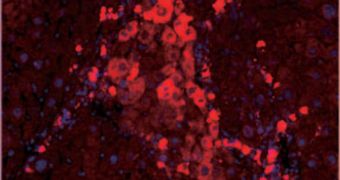A group of investigators in the United Kingdom announces the development of a biotechnology method that enables the creation of liver cells from adult, fully-differentiated skin cells. The approach involves correcting DNA spelling error in the skin cells, and then converting them into induced pluripotent stem (iPS) cells.
According to the team, the discovery could have remarkable applications in the field of regenerative medicine. At this point, researchers prefer to focus on using patients' own bodies to repair damage, rather than intervene from outside.
For liver cancer patients, even the slightest chance that a new treatment could be derived from this research is good news. The condition is extremely aggressive, and has a very poor prognosis in the long run, ScienceNow reports.
The research team that conducted the work says that the approach has thus far only been proven to work on lab mice that had been induced to display liver tumors. Investigators admit that clinical trials are still many years away, but add that the approach could revolutionize cancer treatment.
Stem cells could also help those in need of liver transplant as a result of conditions such as emphysema, cirrhosis and Alpha 1-antitrypsin deficiency (A1ATD). The latter is caused by a malfunctioning protein that builds up in the liver rather than being removed.
In north Europe, these conditions are very widespread among the population. It is estimated that 1 in 2,000 people develop liver conditions, while official statistics show that the number of such patients in the United States exceeds 100,000 yearly.
The new investigation was carried out by experts at the Wellcome Trust and the University of Cambridge. The team says that reprogramming skin cells into iPS cells represents a promising avenue for developing a new treatment against A1ATD .
Details of the amazing research effort were presented in a paper published in the latest issue of the top scientific journal Nature. Experts from the Sanger Institute were also a part of the investigation.
Over the past few years, stem cells have become an important avenue of research for investigators seeking to develop cures for cancer, diabetes and other difficult-to-treat conditions. But perhaps their most significant application is in transplants.
If an organ is grown from a patient's own stem cells, then there is no issue affecting compatibility. People could receive new lungs, livers and hearts without having to take immunosuppressive drugs.

 14 DAY TRIAL //
14 DAY TRIAL //